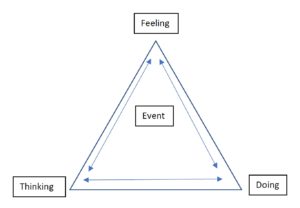Dear John,
I’ve been a perfectionist my whole life. I feel like I could always be doing better, and when someone else points out a mistake I’ve made, I mentally beat myself up for weeks. Is there a way to stop this rumination and learn to move on after I make an error or disappoint myself?
Signed,
Little Miss Perfect
Dear Little Miss Perfect,
You raise numerous concerns that speak to our need as humans to do our best, be effective, get things done correctly, and please others in the process. Naturally, when things don’t go as planned, we can get caught in self-blame and feel criticized and judged. If left unchecked, this can make us feel stuck and depressed.
It may help to deepen your awareness of how your thoughts, emotions, and related behaviors act in relationship, so I offer the below method, which draws from cognitive behavioral therapy.
The Thought-Emotion-Behavior Triangle
Usually our experience goes something like this:
- There is an event that happens to us.
- We have a thought or thoughts about the event.
- We have an emotion about what happened and the thoughts we’re having about it.
- Usually these additional thoughts result in more emotions about what happened, which may fuel further thinking about what happened, which then creates additional emotions on top of the original emotions. This can repeat many times over.
- This entire chain then leads us to engage in a behavior. This behavior, as well as our thoughts and emotions, can be either positive or negative.
This model can be pictured using the Cognitive Triangle.
In this triangle, the event is in the center, and in response to that event we have think, feel, and do at each point of the triangle. The arrowed lines of the triangle reflect how each corner of the triangle is in a bilateral relationship to the other corners. This means that by exerting changes on one point of the triangle, we can bring changes to the other sides as well. So, by changing our thoughts, we can change our feelings and behaviors, and the same applies to any combination of the three.
The components of your situation are:
- Event: someone points out a mistake you’ve made
- Thinking: “I could always do better”
- Feeling: disappointment
- Doing: a) mentally beat yourself up for weeks; b) ruminate
Is the Thought Helpful?
Next, you want to examine these components. Ask yourself:
- Is the thought “I could always do better” accurate?
- Is it helpful?
To answer these questions, it may help to see if the thought fits any of the following categories of unhelpful thinking styles:
- Filtering out the positive and letting in only the negative: letting your entire view of the situation be tainted by negatives.
- Jumping to conclusions: fortune-telling or assuming we know what will happen in a situation or what others are thinking.
- Taking things personally or taking on more blame than is warranted in a situation.
- Catastrophizing: assuming a situation is much worse than it is.
- All-or-nothing thinking: viewing a situation as either perfect or completely ruined, or thinking a person is either all good or all bad.
- “Shoulding” (in an unhelpful way). For example, “I should always get things right the first time.”
- Overgeneralizing: assuming what was in the past will always be the way of the present and future.
- Labeling: putting ourselves or others in a “box.”
- Emotional reasoning: making decisions based upon emotional impressions only. For example, if you feel bad, then you may think that anything you do will not feel good or be fun. You let your emotions taint the moment for the worse.
- Amplifying or minimizing: amplifying the positive traits you see in others and minimizing the good you perceive in yourself.
If your thought fits one of the categories, that is good evidence that it is unhelpful and is not serving you in a positive way.
Related: The Surprising Upside to Negative Thinking
Shifting Your Thinking
Having taken time to reflect on your thought, is there another way that you can think about your situation?
For example, can you try removing the word “always” from your thought and get more specific to the circumstance at hand? It is likely that there have been situations in which you could have performed better, as well as situations where you gave your all and that was enough.
Notice how I am specifying the situation’s nature of the thought, rather than generalizing the thought to all situations. “Sometimes” is usually more accurate than “always”. The key is to create a more balanced and realistic thought that does not fall into any of the unhelpful thinking styles above. Take time to workshop your new thought.
Once you come up with it, check how you feel after having that thought. Does your behavior shift also? For example, you may notice that you feel relief, and instead of ruminating and beating yourself up, you simply get on with your day with a clearer mind and a relaxed body.
Another approach is to reframe your thinking about mistakes into learning opportunities. Rather than beating yourself up, can you get curious about how this situation is grist for the mill? What can you learn from it that can lead to greater mastery in the future? This helps move you toward a growth mindset instead of a fixed one.
The last point I’d like to discuss is how to get out of rumination when you are in it. Like anything, there are numerous methods that can be utilized. I suggest a very simple concept called objectifying the thought. (This exercise is from The Relaxation and Stress Reduction Workbook by New Harbinger Publications. Kindle Edition.)
When you notice you are caught in rumination, choose one of those worrisome thoughts and objectify it by visualizing it coming into form: What colors does it have? What shape? If the thought had a smell, what would it be? Is it an object that has a sound? Would this thought have a certain flavor or taste?
By putting the thought into an objective form, you can visualize acting upon it to release it. For example, perhaps the thought appears as a storm cloud in the sky that has lightning and thunder. You can then imagine that by connecting to your breath and using deep breathing, you can blow these storm clouds away and visualize sunlight brightening the now open blue sky.
We covered quite a lot of material. Take time to play with these concepts and practices. Approach this material from that growth mindset with your goal being to learn and grow, rather than worry and dwell. You will know when your process has yielded a good enough solution because you will feel better and freer. Trust yourself.
I thank you so much for writing in and entrusting me with your question. I wish you the best on your journey.
Warmly,
John












Comments (0)